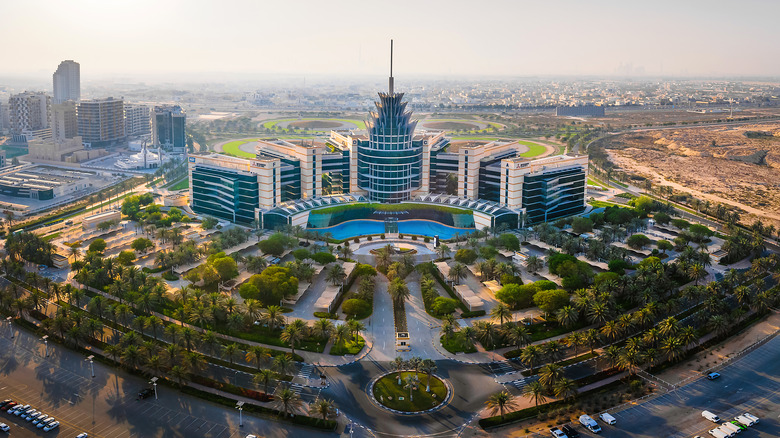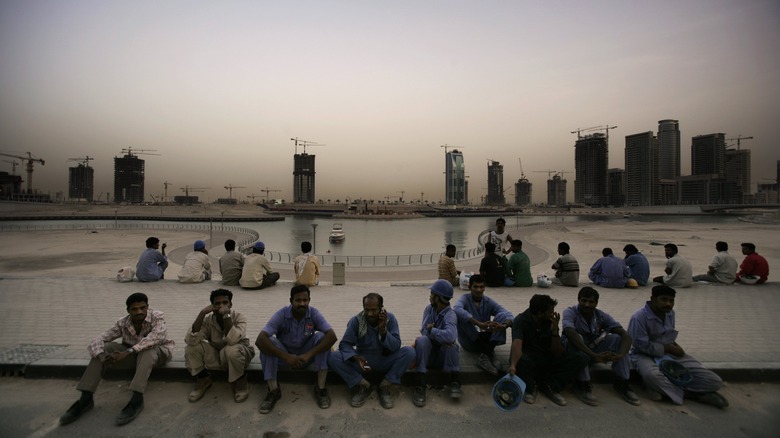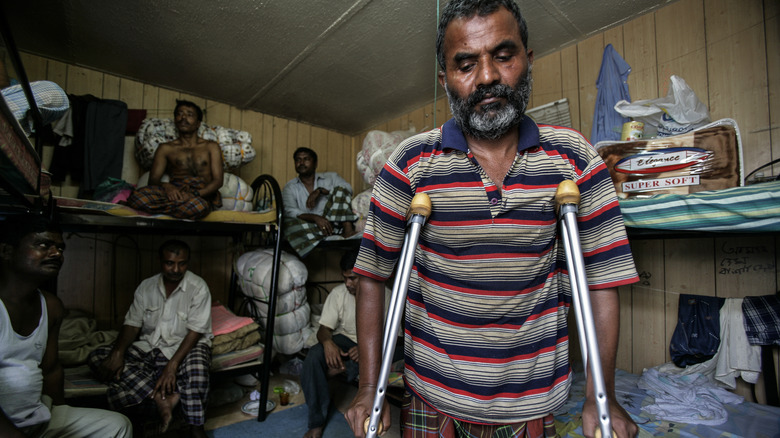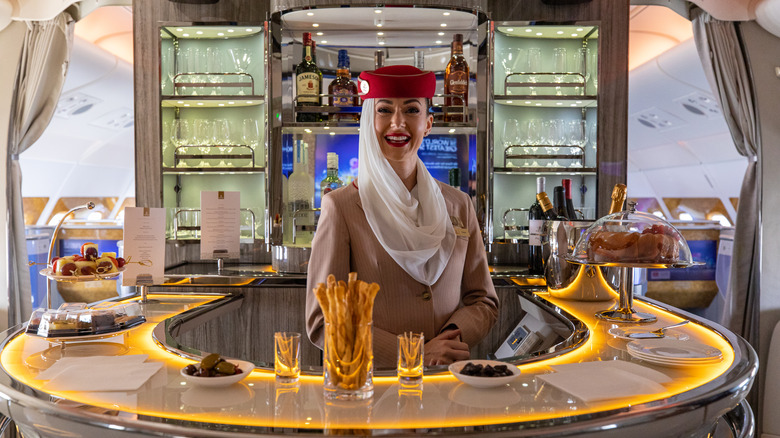The Real Human Cost Behind The Building And Maintenance Of Dubai
In many ways, Dubai is something of a marvel of the modern world. Its terraformed expanse of skyscrapers, futuristic gardenscapes, theme and water parks, and indoor, temperature-controlled ski resorts are built on top of shifting sand dunes along the coast of the Persian Gulf: saltwater on one side, expansive desert on the other. It's gone from a fishing village around 2,500 BCE, per Visit Dubai, to a completely artificial construct incongruously at odds with nature, built from a wellspring of human ingenuity, technological prowess, and nigh-endless oil money. Starting in 1966, Prime Minister Sheikh Rashid bin Saeed Al Maktoum spared no expense in creating a world-class city, and the result is the United Arab Emirates' (UAE) global standard-bearer of financial prosperity and a diverse, immigrant-flush population of 3.4 million. Heck, the government even recently commissioned weather-control projects to offset the city's extreme vulnerability to climate change.
Under the windblown sand and glassy, air-conditioned veneer, though, lives an equal and opposite face of usury, depredation, and shocking human rights abuses. Cracks splinter Dubai's opulent illusion. The Burj Khalifa, for instance, the world's tallest building at 828 meters tall (more than 2,700 feet, or over half a mile), has no sewage system, as Gizmodo reports. Trucks queue up for miles, waiting up to 24 hours, to ferret away the building's 15 tons of daily refuse to who knows where.
This circumstance is comparatively benign, though, and merely scratches the surface when it comes to labor and construction issues in Dubai.
A huge migrant population with limited legal rights
As the Carnegie Endowment for International Peace cites, 90% of the UAE's population consists not of locals, but of foreign nationals. Many of them are "low-wage and semi-skilled workers" from various African nations, Asian countries such as Pakistan, Bangladesh, India, and the Philippines, and other Middle Eastern countries brought in specifically for construction purposes. Such migrant workers are shipped en masse and promised work for a couple of years for around 1,000 dirhams a month (about $270, per Reuters). Meanwhile, as stated in a report by the Government of Dubai Statistics Center, 99.3% of native Emirati work in white-collar jobs, and garner, on average, (per Payscale) 109,000 dirhams a year (about $29,000). One-third of the population isn't seeking employment (almost a million people) in a city of 52,000 millionaires, per Arabian Business.
These simple figures alone illustrate and typify the UAE's economic disparity. As the Human Rights Watch puts it, the entirety of the UAE "facilitates and fosters abuse and exploitation of domestic workers." In the end, as a damning report by Gulf Labor Markets and Migrations relates, migrant workers are left underpaid, if they're even paid at all. They're often packed 8 persons to a tiny room with minimal toilet facilities, stripped of their passports, subjected to "mental and physical torture" (per the Business and Human Rights Resource Centre), left to starve (per The Guardian), and much more. It's essentially human trafficking and slavery under the guise of contractual, paid work.
Tortured and enslaved with no recourse except suicide
Back in 2005 when the Burj Khalifa was being built, 7,000 workers protested their horrific working conditions, per Migrant Rights. That same year 500 Indian laborers committed suicide, per In Defense of Marxism. Men jumped out of buildings in labor camps rather than live, as Reuters says. They still do.
They queue at 4 a.m. just to use the bathroom before being carted off for 16 to 18-hour workdays. They work in temperatures over 120 degrees Fahrenheit with no shade, get sick, and as the Guardian says, spend their meager salaries on medical bills. "It has been over a year since I was able to send any money home. Because I am starving, I can't send anything," 39-year-old Ansar Abbas said in 2020, "We want to escape. But I can't go back with nothing ... Nobody is listening to us. Nobody can feel our pain." In 2019, the Business and Human Rights Resource Centre reported multiple cases of the "mental and physical torture" of the unpaid whose passports had been confiscated. They were unable to even leave the country.
The same fate faces both men and women. Filipina Jeany Alfiler, who told her story to Human Rights Watch, was attacked and seared with her own hot clothing iron when she confronted her "Madame" about needing more time to finish her work. Others were told "I bought you" and "We can easily have you killed."
The "kafala" labor system has undergone minimal reforms
So how is it possible that such deplorable, inhumane treatment of person to person can persist without anyone lifting a finger to intervene? Much of it, ostensibly, boils down to "kafala," which the Council on Foreign Relations describes as the UAE's "sponsorship" system where domestic companies retain almost complete, legal control over migrant, contracted workers. Such "legal frameworks" define the relationship between employer and employee, and were deliberately designed to produce cheaper labor in a way akin to medieval serfdom. As the Carnegie Endowment for International Peace cites, the United Nations has pointed to the kafala system as opening a huge gateway for forced labor and sex trafficking.
As a result, as Nesrine Malik stated in The Guardian, Dubai itself is a place "Where the worst of western capitalism and the worst of Gulf Arab racism meet in a horrible vortex. The most pervasive feeling is of a lack of compassion, where the commoditization of everything and the disdain for certain nationalities thickens the skin to the tragic plight of fellow human beings." Dubai's skyscrapers and garish, photo-op luxury are not figuratively built on the blood of slaves, but literally. And all this in the middle of a desert where people can ski indoors.
In 2007, the UAE set up its National Committee to Combat Human Trafficking to oversee "antitrafficking law and to coordinate government efforts to combat trafficking." Steps like these have been taken to redress this terrible state of affairs, albeit minimally.



